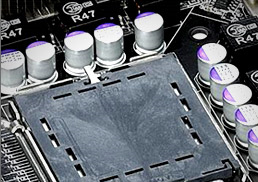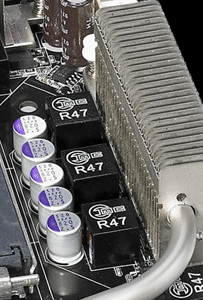Asus P5N32-SLI: Dual x16 - What Dreams Are Made On . . .
by Gary Key on October 27, 2005 12:05 AM EST- Posted in
- Motherboards
This line as spoken by the magician Prospero in William Shakespeare's whimsical play, "The Tempest", reminds us of the uniqueness of the human mind and the fleeting amount of time that we are around to utilize it."We are such stuff, As dreams are made on and our little life
Is rounded with a sleep..."
The Asus P5N32-SLI Deluxe that we will review today is also very unique in several ways and like most computer products in the current marketplace, its life span will be fleeting. However, for those of you who have the opportunity to utilize it, you will find what dreams are made on.
I will say this up front; this is one of the better motherboards that I have had the opportunity to use in the last 20 years. In fact, this board deserves additional testing time in order to explore fully and extract all of its performance potential. In keeping with what we believe is the best option for the current Intel processor lineup, the Pentium D series, we did not test a single core processor on this board. However, based upon the results that we extracted from the 840EE and 820D processors, we will be testing a single core processor on this board in the near future.
While it does not have the quad graphics capability of the Gigabyte GA-8N SLI Quad, the stellar layout of the MSI P4N Diamond, or the extensive feature set of the Gigabyte GA-8I955x Royal that was reviewed recently, this board's capability more than exceeds the sum of its parts. Yes, it does have some quirks as most products will, but Asus has engineered a truly remarkable motherboard utilizing the revised NVIDIA nForce4 Intel Edition SLI for the Northbridge and the NVIDIA nForce4 SLI for the Southbridge resulting in the x16 designation.


 |
 |
One of the main design features that Asus engineered into this board is an exclusive 8-phase voltage regulator power design that can significantly lower operating temperatures while reducing input ripple current and output ripple voltages . In fact, the input ripple current is over three times lower than a traditional 4-phase design while output ripple voltages are four times lower. The power consumption compared to the 4-phase design is about 10% less while the 8-phase design has the advantage of quicker transient responses and increased dependability due to lower thermal values.
What all this means is that your system will run cooler and overclock better compared to other solutions. In fact, through informal testing utilizing the BIOS readings, we found our Intel Pentium 840EE was on average running about 5c cooler in the Asus board compared to other solutions in the same test setup and ambient conditions. We will be conducting more thermal tests with scientific instrumentation in the near future. Our average overclocks were around 5% better than the other boards at more aggressive memory timings and with lower voltages required to the chipsets. While this does not sound like much, the ability of this board to run a CPU that previously topped out in the 3.9GHz range at up to 4.2GHz is impressive. The Asus P5N32-SLI Deluxe was an extremely stable board throughout our testing and did not fail a single time throughout two weeks of varying tests and conditions.
Let's see what this board is capable of now.










70 Comments
View All Comments
Gary Key - Sunday, October 30, 2005 - link
Asus will be clarifying the supported range of CPUs with the Lock Free setting. I noticed a difference this weekend on the retail board and bios with a CPU stepping range I thought was fully supported. I know the EE series all work properly, the balance I am not sure of at this time.
Gary Key - Thursday, October 27, 2005 - link
It will allow you to go down to 14x only in my testing. I did not have an issue with the dual core cpus down to 14x or raising the 820D to 16x. However, I have a single core cpu coming and will verify the settings with it. Please email me so I can repsond to you directly.Spacecomber - Thursday, October 27, 2005 - link
I think a more to the point intro would have been to ask whether a $250 motherboard can make up for the shortcomings in the current line of Intel desktop processors and make them more attractive to the computer enthusiast.Then again, maybe people who are sticking with their Prescotts really are dreamers.
Gary Key - Thursday, October 27, 2005 - link
Good point and one that Intel finally understands but we will have to wait until next summer to see the results. :) However, this board does make up for some of the current Intel CPU shortcomings and is truly an enthusiast board for Intel customers.tuteja1986 - Thursday, October 27, 2005 - link
Asus were leader once and i think are going to take the leader crown again: )They have been getting good success with:
Dual GPU 7800GTX
Now This motherboard
Also they are working on 7300 go
Good work and keep it up
Bozo Galora - Thursday, October 27, 2005 - link
reads like an ad for asuswho the hell would use a current Intel cpu?
not the 80% of the people who come to AT
I'll take the upcoming (delayed again) DFI NF4 Expert mobo, thank you
Gary Key - Thursday, October 27, 2005 - link
If it means anything, I purchased a pair of these boards after I completed the initial testing to replace a couple of systems in our household. I am that confident in the board and its ability.
About 80%+ of the buying public currently although the numbers are greatly skewed in their favor by large OEM and Retail sales. Actually, the newer Intel products are decent performers at a good price point. However, I completly agree that AMD owns the performance market and should receive wider credit for their efforts over the past couple of years.
Agreed, but sometimes it is good to visit the other side of the fence. A few short years ago your statements would have held true for people with AMD systems. ;-)
An excellent choice but while you are waiting you could purchase this board now. :-)
karioskasra - Thursday, October 27, 2005 - link
Dreams are made on an Intel platform? Did I miss something here...Gary Key - Thursday, October 27, 2005 - link
If you have an Intel CPU, then no, you did not miss anything. ;->I fully understand the performance and cost advantages the current AMD64 platform has over Intel. However, this should not dismiss the fact that the NVIDIA nForce4 SLI platform along with the implementation of it by Asus is an excellent solution regardless of CPU choice.
I personally own several AMD64 platforms but in reality you would be hard pressed at this time to tell the difference in performance between the two without benchmarks. I realize there will be a small population that can but overall an current Intel based system is fine for gaming and applications.
ksherman - Thursday, October 27, 2005 - link
I REALLY like the fan less northbridge cooling setup... Wish my DFI had one like it. Esp. since my Zalman 7700 will keep those heasinks nice and cool...